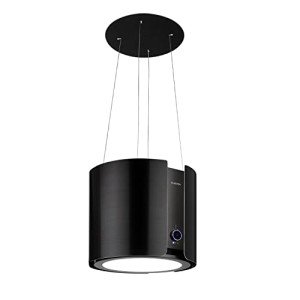7 Helpful Tricks To Making The Profits Of Your Island Vent Hood

How to Aerate an Island Vent Hood
Suspended from the ceiling, an island vent hood assists distribute air and keeps your kitchen without smoke and smells. It's also a stylish function that enhances your cooking space.
island cooker extractor include external venting, which pushes air through ductwork to the exterior of your home, and recirculating designs that filter and recycle cooking fumes. Some hoods can even be transformed in between one and the other.
Ventilation
Unlike wall-mounted range hoods that vent air vertically through the wall to the outdoors, island vent hoods utilize ductwork that goes through the ceiling to exhaust the cooking location to the outdoors. The difference is that they can also be used to recirculate air.
Discover our choice of business and designer custom hoods with effective ventilation systems. With personalized requirements, discover the perfect hood for your kitchen space.
Dacor's ConnectOn auto-responsive technology turns on the hood and increases the fan speed in response to the cooktop, providing effective efficiency while utilizing minimal noise. It's just another manner in which you can prepare with self-confidence. Include a touch of modern with this stainless-steel pyramid-style wall-mount canopy hood. This hood gracefully accents advanced kitchens that follow a more standard design style and clarifies of smoke, steam and cooking smells.
Style
Unlike wall-mounted range hoods that are mounted versus the wall, island vent hoods are suspended from the ceiling over an island or peninsula cooktop or range. They also utilize ductwork to exhaust air out of the home. This design is best for kitchen areas that have a great deal of open space, and it assists to include visual interest to your space. This new home features Blackberry stained cherry kitchen cabinetry on the parameter, and a natural stacked stone on the island and vent hood to complement the Gunstock stain on the cabinets. 10ft ceilings and a skylight assistance to keep the kitchen intense and large.
Noise
While an island vent hood does a terrific job of filtering smoke, grease and smells out of your kitchen, it can likewise produce some noise that interferes with the tranquility of your cooking space. Luckily, there are some techniques you can employ to reduce this sound and enable you to prepare in peace.
One of the main causes of excess range hood noise is triggered by fan motor problems such as stiff bearings or badly lubed fans that produce a loud humming noise. Ductwork can also contribute to this issue especially if the ducts are too small or if they are obstructed with dust.

The very best method to reduce sound is to make sure that your vent hood has the greatest airflow score that you can afford. The Home Ventilating Institute (HVI) recommends an airflow rate of 100 to 250 cfm for wall-mounted hoods over 30-inch large ranges. This hood needs to also have a multispeed fan to permit lower fan speeds throughout light cooking. Among the easiest methods to reduce the noise is to make certain that the ducting is smooth-walled, as corrugated duct limits airflow. You need to likewise keep the duct runs as short and straight as possible to avoid any kinking.
Installation
Ventilation of island range hoods is a various procedure than wall-mounted systems, given that they are suspended from the ceiling over an island or peninsula cooktop or range. They typically require a duct that goes through the ceiling and out through the roofing, which can be a complex project for an unexperienced homeowner.
In addition, they should be set up at least 24-inches to 36-inches above the cooking surface area. The height might differ, depending on the size of the hood and the ceiling. If you have existing ducting and electrical wiring in the kitchen ceiling, this kind of vent hood is fairly simple to install. If not, it's suggested that you speak with an expert.
To begin setup, make certain the hood can fit through the opening you have actually chosen for the vent which it's the best width to accommodate the ductwork and exhaust. If the hood is too broad, it can lessen the efficiency of the vent and will increase noise levels. Next, cut a little hole in the ceiling and utilize a wire cutter to inspect that there's no plumbing or electrical circuitry near the hole. If there is, think about working with an expert for the task or changing to a recirculating system.
If there isn't, you can start the larger vent hole by drilling locator holes with a drill and a 1/2-inch masonry bit in each corner of the location. Then use a jigsaw to cut the larger vent hole. Lastly, add a drywall spot and paint to end up the job. As soon as the hood remains in location, you can run the electrical circuitry and connect it to your breaker box. Follow your maker's instructions for complete installation information.
